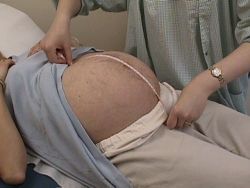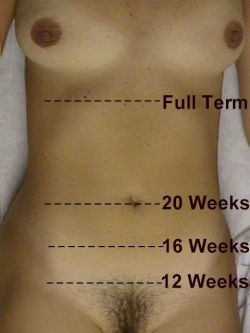Gestational Age - Clinical
If everyone had normal, regular periods, every 28 days, and could remember exactly when their last period was, and ovulation always occurred on day #14 of the menstrual cycle, then gestational age determination would be easy. These assumptions, however, are not always the case. In real life, determining gestational age can be challenging.
The estimated delivery date is calculated by adding 280 days to the first day of the last menstrual period. An alternative method of determining the due date is to add 7 days to the LMP, subtract three months, and add one year. These calculations are made easier with the use of a pregnancy wheel or Gestational Age Calculator.
| <a class="external" href="http://www.brooksidepress.org/Products/Military_OBGYN/Textbook/Pregnancy/OBMeasure2.jpg" rel="nofollow" target="_blank"> </a> </a>MacDonald's Rule (Cm of fundal height = weeks gestation) |
Ultrasound can be used to determine gestational age. Measurement of a crown-rump length during the first trimester (1-13 weeks) will give a gestational age that is usually accurate to within 3 days of the actual due date. During the second trimester (14-28 weeks), measurement of the biparietal diameter will accurately predict the due date within 10-14 days in most cases. In the third trimester, the accuracy of ultrasound in predicting the due date is less, with a plus or minus confidence range of as much as 3 weeks.
A chart showing different ultrasound measurements at different gestational ages in shown in the Ultrasound Gestational Age Measurements chart.
Go back to obstetrics home page
